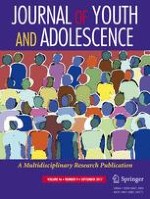17-03-2017 | Empirical Research
Everything’s Gonna be Alright! The Longitudinal Interplay among Social Support, Peer Victimization, and Depressive Symptoms
Gepubliceerd in: Journal of Youth and Adolescence | Uitgave 9/2017
Log in om toegang te krijgenAbstract
Peer victimization has been identified as a risk factor for depressive symptoms. The current study investigated the longitudinal interplay among social support, peer victimization and depressive symptoms in early adolescence. We specifically investigated the promotive and protective role of parental and friendship support on the longitudinal relationship between victimization and depressive symptoms. A total of 960 Swiss adolescents (49% female, Mage 13.2 years) completed an electronic questionnaire four times, with 6-month intervals. Trivariate cross-lagged models with latent longitudinal moderations were computed. The analyses confirmed that peer victimization was positively associated with changes in depressive symptoms, and depressive symptoms were positively associated with changes in victimization. Furthermore, bidirectional longitudinal associations between both parental and friendship support and depressive symptoms were found, while neither parental nor friendship support was found to be longitudinally associated with peer victimization. Further, neither parental nor friendship support moderated the longitudinal relationship between victimization and depressive symptoms. Thus, the present results suggested that parental and friendship support were promotive factors for adolescents’ well-being, while neither parental, nor friendship support buffered the effect of victimization on depressive symptoms, thereby yielding no evidence for their longitudinal protective effect.
